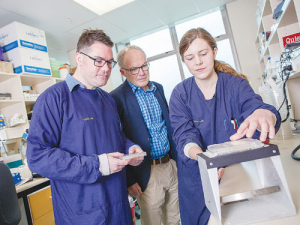Breeding mastitis-resistant cows
Selecting for disease- resistant cows has become a reality for farmers around the globe as genetic developments continue to advance.
 Leading researchers Phd student Nichaela Harbison-Price (right) and Dr Scott Ferguson (left), with Professor Greg Cook at University of Otago lab.
Leading researchers Phd student Nichaela Harbison-Price (right) and Dr Scott Ferguson (left), with Professor Greg Cook at University of Otago lab.
Innovation is long overdue in mastitis management to protect New Zealand farmers’ global leadership in dairying, says an academic.
University of Otago Professor Gregory Cook is leading research to develop new sanitisers to manage the disease, which costs the dairy industry $280 million annually in treatment and discarded milk.
The industry now relies on two antimicrobial sanitisers to control mastitis, administered through teat sprays. Both formulations contain bioactive ingredients -- chlorhexidine (CHX) or iodine -- that are also widely used to control infection in hospitals. But there is a rising call for new types of products for the dairy industry, because of a mounting threat of antimicrobial resistance in clinical environments and lower acceptance of chemical residues in consumer products.
Cook says though iodine and CHX-based products remain effective under NZ conditions, both are ageing technologies.
“Innovation in this area is long overdue to protect NZ farmers’ status as global dairy leaders. There is a risk in this huge industry relying on only two sanitising molecules, particularly given the globally growing threat of antimicrobial resistance (AMR) and trends in reducing antimicrobial usage,” he told Dairy News.
“Previous experience shows how vulnerable dairy exports can be to fickle overseas market perceptions of apparently ‘harmful’ materials ending up in products, even if those molecules are, in reality, perfectly safe.
“So the NZ dairy industry [must] invest in new, highly effective molecules and reduce the levels of antimicrobials now in use.”
Cook hopes farmers will get “a great new sanitiser” to keep mastitis cases to a minimum, maximising herd health and productivity. Working with him are researchers at the Universities of Otago and Auckland, and the NZ animal health company Deosan.
He says these colleagues “tick all the boxes for this project to be a success – respected individuals with strong track records in their areas of expertise including microbiology, chemistry and animal health products”.
“By combining leading academic researchers with industry innovators we’re able to get the right balance between ‘blue-sky’, outside-the-box thinking and practical onfarm solutions, to turn our discoveries in the lab into products that work in the real world.”
Deosan chief executive officer Kip Bodle says the company has developed specialist knowledge in formulating CHX teatspray products; the university researchers agree that any final product should not compromise teatskin by being too acidic.
He says Deosan has for some time advocated neutral pH teatspray to ensure a healthy skin environment. “A healthy teat end is the most effective preventative on the market,” he says.
The work has attracted a grant of $1.7 million from the Ministry of Business, Industry and Enterprise.
Bodle says the project collaborators are intent on NZ maintaining global leadership in producing quality milk, and are “engaging with government and industry leaders to [succeed] in commercialising products that could have global significance”.
“Recent experience in the international arena suggests NZ innovation in milk quality [impresses] emerging dairy markets”.
Cook’s team includes Drs Michelle McConnell and Adam Heikal, supported by a University of Auckland team led by Professor Margaret Brimble.
Antimicrobial usage
Professor Greg Cook says there is a need to reduce the levels of antimicrobials used in the industry.
He says in any environment where antimicrobials are used in large amounts -- hospitals, farms, communities -- there is antimicrobial resistance (AMR). It is the natural response of any bacterium to an antimicrobial.
“The key is to reduce the levels of antimicrobials we are using; less antimicrobial use equals less AMR. Hence the discovery of new sanitisers becomes critically important, as ultimately this will reduce the amount of antimicrobials being used and impact directly on AMR.”
Deeply cynical and completely illogical. That's how Kimberly Crewther, the executive director of DCANZ is describing the Canadian government's flagrant breach of international trade law in refusing to open its market to New Zealand dairy exports.
This week the winner of the prestigious Ahuwhenua Trophy for the top Māori Dairy farm will be announced at a gala dinner in Hamilton.
Once-a-day milking (OAD) can increase or lower the amounts of proteins in milk, according to a new study published in the journal Dairy.
Rabobank says climate change creates both risks and opportunities for the bank and its clients and that the food and agriculture sector needs to recognise the potential for both.
Eastern Bay of Plenty farmer Rebecca O’Brien was named the 2024 Dairy Women’s Network (DWN) Regional Leader of the Year.
Humbling, overwhelming, and an absolute honour. That’s how 2024 Fonterra Dairy Woman of the Year Katrina Roberts describes her win at the Dairy Women’s Network conference earlier this month.
OPINION: Not everyone will agree with former 'Minister of Everything' Stephen Joyce on his summation of Fonterra when writing recently…
OPINION: A plug is overdue for Meat the Need, who is currently fundraising to help supply more meals to families…